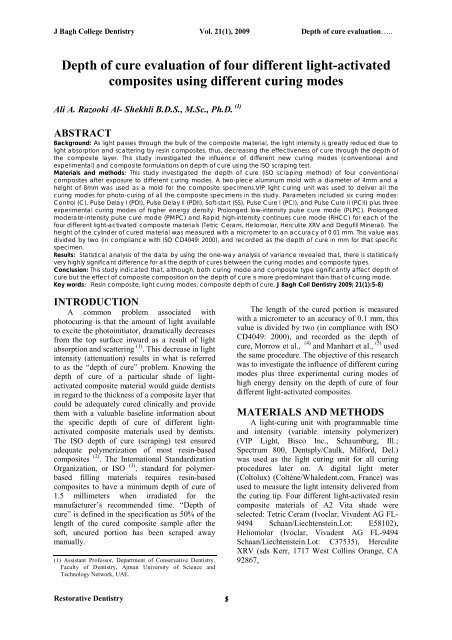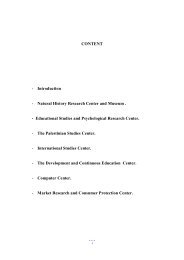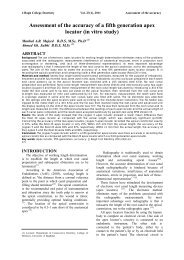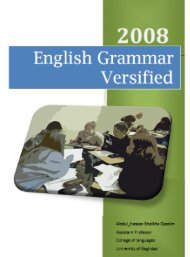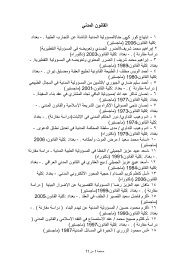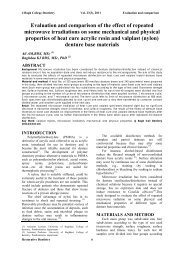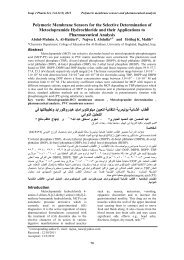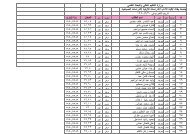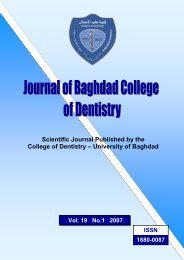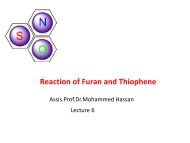Vol 21 No. 1
Vol 21 No. 1
Vol 21 No. 1
Create successful ePaper yourself
Turn your PDF publications into a flip-book with our unique Google optimized e-Paper software.
J Bagh College Dentistry <strong>Vol</strong>. <strong>21</strong>(1), 2009 Depth of cure evaluation…..<br />
Depth of cure evaluation of four different light-activated<br />
composites using different curing modes<br />
Ali A. Razooki Al- Shekhli B.D.S., M.Sc., Ph.D. (1)<br />
ABSTRACT<br />
Background: As light passes through the bulk of the composite material, the light intensity is greatly reduced due to<br />
light absorption and scattering by resin composites, thus, decreasing the effectiveness of cure through the depth of<br />
the composite layer. This study investigated the influence of different new curing modes (conventional and<br />
experimental) and composite formulations on depth of cure using the ISO scraping test.<br />
Materials and methods: This study investigated the depth of cure (ISO scraping method) of four conventional<br />
composites after exposure to different curing modes. A two-piece aluminum mold with a diameter of 4mm and a<br />
height of 8mm was used as a mold for the composite specimens.VIP light curing unit was used to deliver all the<br />
curing modes for photo-curing of all the composite specimens in this study. Parameters included six curing modes:<br />
Control (C), Pulse Delay I (PDI), Pulse Delay II (PDII), Soft-start (SS), Pulse Cure I (PCI), and Pulse Cure II (PCII) plus three<br />
experimental curing modes of higher energy density: Prolonged low-intensity pulse cure mode (PLPC), Prolonged<br />
moderate-intensity pulse cure mode (PMPC) and Rapid high-intensity continues cure mode (RHCC) for each of the<br />
four different light-activated composite materials (Tetric Ceram, Heliomolar, Herculite XRV and Degufill Mineral). The<br />
height of the cylinder of cured material was measured with a micrometer to an accuracy of 0.01 mm. This value was<br />
divided by two (in compliance with ISO CD4049: 2000), and recorded as the depth of cure in mm for that specific<br />
specimen.<br />
Results: Statistical analysis of the data by using the one-way analysis of variance revealed that, there is statistically<br />
very highly significant difference for all the depth of cures between the curing modes and composite types.<br />
Conclusion: This study indicated that, although, both curing mode and composite type significantly affect depth of<br />
cure but the effect of composite composition on the depth of cure is more predominant than that of curing mode.<br />
Key words: Resin composite, light curing modes, composite depth of cure. J Bagh Coll Dentistry 2009; <strong>21</strong>(1):5-8)<br />
INTRODUCTION<br />
A common problem associated with<br />
photocuring is that the amount of light available<br />
to excite the photoinitiator, dramatically decreases<br />
from the top surface inward as a result of light<br />
absorption and scattering (1) . This decrease in light<br />
intensity (attenuation) results in what is referred<br />
to as the “depth of cure” problem. Knowing the<br />
depth of cure of a particular shade of lightactivated<br />
composite material would guide dentists<br />
in regard to the thickness of a composite layer that<br />
could be adequately cured clinically and provide<br />
them with a valuable baseline information about<br />
the specific depth of cure of different lightactivated<br />
composite materials used by dentists.<br />
The ISO depth of cure (scraping) test ensured<br />
adequate polymerization of most resin-based<br />
composites (2) . The International Standardization<br />
Organization, or ISO (3) , standard for polymerbased<br />
filling materials requires resin-based<br />
composites to have a minimum depth of cure of<br />
1.5 millimeters when irradiated for the<br />
manufacturer’s recommended time. “Depth of<br />
cure” is defined in the specification as 50% of the<br />
length of the cured composite sample after the<br />
soft, uncured portion has been scraped away<br />
manually.<br />
(1) Assistant Professor, Department of Conservative Dentistry,<br />
Faculty of Dentistry, Ajman University of Science and<br />
Technology Network, UAE.<br />
The length of the cured portion is measured<br />
with a micrometer to an accuracy of 0.1 mm, this<br />
value is divided by two (in compliance with ISO<br />
CD4049: 2000), and recorded as the depth of<br />
cure, Morrow et al., (4) and Manhart et al., (5) used<br />
the same procedure. The objective of this research<br />
was to investigate the influence of different curing<br />
modes plus three experimental curing modes of<br />
high energy density on the depth of cure of four<br />
different light-activated composites.<br />
MATERIALS AND METHODS<br />
A light-curing unit with programmable time<br />
and intensity (variable intensity polymerizer)<br />
(VIP Light, Bisco Inc., Schaumburg, Ill.;<br />
Spectrum 800, Dentsply/Caulk, Milford, Del.)<br />
was used as the light curing unit for all curing<br />
procedures later on. A digital light meter<br />
(Coltolux) (Coltène/Whaledent.com, France) was<br />
used to measure the light intensity delivered from<br />
the curing tip. Four different light-activated resin<br />
composite materials of A2 Vita shade were<br />
selected: Tetric Ceram (Ivoclar, Vivadent AG FL-<br />
9494 Schaan/Liechtenstein.Lot: E58102),<br />
Heliomolar (Ivoclar, Vivadent AG FL-9494<br />
Schaan/Liechtenstein.Lot: C37535), Herculite<br />
XRV (sds Kerr, 1717 West Collins Orange, CA<br />
92867,<br />
Restorative Dentistry 15


